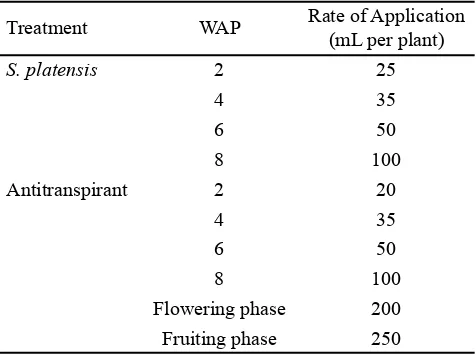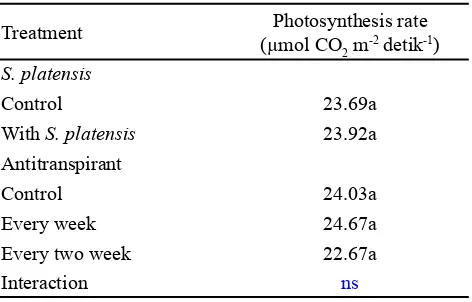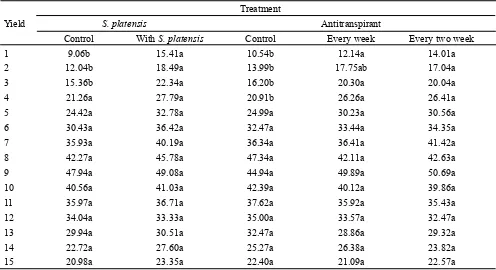* Corresponding author. e-mail: sudradjat_ipb@yahoo.com INTRODUCTION
Chili pepper plant is very sensitive to nutrient deficiencies both macro and micro. Low nutrient avaibility in soil influences early growth of chilli pepper, which subsequently affects the yield (Agustin et al., 2010). Nutrient deficiencies causes severe problems in plant cell metabolism which finally led to growth reduction and yield loss. Application of bio stimulator as foliar fertilizer
containing plant growth regulators, polyamines, and vitamins effective to overcome nutrient deficiencies (Shalaby and El Ramady, 2014). Kowalczyk and Zielony (2008) stated that these compounds improves plant resistance and tolerance to environmental stresses. One of bio stimulators is Spirulina platensis contains protein, amino acid, minerals and vitamins. Chemical analysis of S. platensis as bio-stimulator revealed that it contains 6.7% N, 2.47% P and 2.14% K as well as adequate amounts of micro elements needed for plant nutrition (Aly and Esawy, 2008). Previous studies have shown that S. platensis as bio stimulator increased growth parameters and yield on pepper (Aly and Esawy, 2008) and garlic (Shalaby and El Ramady, 2014).
Effects of Dry Spirulina platensis and Antitranspirant on Growth and Yield of Chili Pepper (Capsicum annuum L.)
Afifah Farida Jufri1, Sudradjat2*, and Eko Sulistyono2
1Graduate Student of Agronomy and Horticulture Study Program, Bogor Agricultural University 2Department of Agonomy and Horticulture,Faculty of Agriculture, Bogor Agricultural University
Jl. Meranti, Kampus IPB Darmaga, Bogor 16680, Indonesia Received 23 February 2015/Accepted 8 March 2016
ABSTRACT
Chili pepper (Capsicum annuum L.) plant is very sensitive to nutrient deficiences. The alternative effective approach is trough application of bio stimulator. The objective of this research was to study the effect of Spirulina platensis dry biomass and antiranspirant on chili pepper growth and yield. This research was conducted at Dramaga District, Bogor Regency, West Java Indonesia from February to July 2014. The experiment was arranged in a factorial split plot design with three replications. The main plot was S. platensis application which consisted of two levels, i.e., without S. platensis (control) and with S. platensis application (S1). The subplot was antitranspirant which consisted of three levels of interval application, there were without antitranspirant (A0), weekly (A1) and fortnightly (A2). The results showed that application of S. platensis and antitranspirant had no significant effect on physiological responses, vegetative growth and yield components. Application of S. platensis and antitranspirant weekly on chili pepper increased marketable product by 2.1%..
Keywords: S. platensis, bio stimulator, nutrient
ABSTRAK
Tanaman cabai merah (Capsicum annuum L.) merupakan tanaman yang sensitive terhadap kekurangan nutrisi. Salah satu cara yang efektif untuk memenuhi kebutuhan nutrisi tersebut adalah dengan memberikan bio stimulator. Penelitian ini bertujuan untuk mengetahui pengaruh aplikasi biomassa kering Spirulina platensis dan antitranspiran terhadap pertumbuhan dan produksi cabai. Penelitian dilakukan di Dusun Lembur Leutik, Desa Cikarawang, Kecamatan Dramaga, Kabupaten Bogor, Jawa Barat pada bulan Februari hingga Juli 2014. Rancangan penelitian yang digunakan adalah rancangan split plot faktorial. Petak utama adalah aplikasi S. platensis yang terdiri atas dua taraf perlakuan yaitu tanpa S. platensis (S0) dan dengan aplikasi S. platensis (S1). Anak petak adalah interval aplikasi antitranspiran yang terdiri atas tiga taraf perlakuan, yaitu tanpa antitranspiran (A0), pemberian antitranspiran setiap minggu (A1) dan setiap dua minggu (A2). Hasil penelitian menunjukkan bahwa aplikasi S. platensis dan antitranspiran tidak memberikan pengaruh yang nyata terhadap respon fisiologi, pertumbuhan vegetatif dan komponen hasil. Aplikasi S. platensis dan pemberian antitranspiran setiap minggu nyata meningkatkan hasil layak pasar sebesar 2.1%.
One of the major critical enviromental factors affecting chili pepper growth and yield is water status. The plant used 5% water absorption to plant growth and development and 95% were lost to transpiration (Prakash and Ramachandran, 2000). Therefore, it is essential to keep pace with transpiration and water uptake by roots.
Reducing transpiration by application of antitranspirant could save considerable quantities of water and also reduce plant stress due to water deficits (Del Amor et al., 2006; Goreta et al., 2007). Pinto and Torres-Pereira (2006) indicated that the reflective coating spray of antitranspirant onQuercus suber L. plants reduced leaf temperature and water loss. The study of Del Amor et al. (2010) found that antitranspirant did not affect photosynthesis rate, while leaf temperatures, stomatal conductance and transpiration rate of sweet pepper plants were reduced. Jifon and Syvertsen (2003) reported that antitranspirant increases reflectance and reduces midday leaf temperature.
One of the active ingredients of antitranspirant is di-1-p-menthene terpene polymers of pine trees. Application of di-1-p-menthene emulsion on tuberous flower increased plant growth grown in mild water stress (Al Humaid and Moftah, 2005). Everett et al. (2008) suggested that the use of di-1-p-menthene protects plants from fungal attack.
The objective of this research was to study the effect of S. platensis application as bio stimulator and di-1-p-menthene containing antitranspirant as leaf coatings on chili pepper (Capsicum anuum L.) growth and productivity.
MATERIALS AND METHODS
Application of S. platensis and antitranspirant on chili pepper were evaluated at Dusun Lembur Leutik, Cikarawang Village, Dramaga District, Bogor Regency, West Java Indonesia from February to July 2014 and the elevation of the experimental site was 250 m above sea level. Soil analysis was carried out at Soil Laboratory, Department of Soil Science and Land Resources, Bogor Agricultural University. Post harvest observation was carried out at Post Harvest Laboratory, Department of Agronomy and Horticulture, Bogor Agricultural University.
Chili pepper TM99 var Seminis, S. platensis dry biomass cointaining protein, amino acid, minerals and vitamins as bio stimulator, and di-1-p-menthene (904.32 g L-1) containing antitranspirant powder were used. The
experimental design was factorial split plot design with three replications. Observation were taken on ten sample plants for each replication. The main plot was S. platensis
consisted of two levels, i.e., without S. platensis and with
S. platensis application. The subplot was antitranspirant application, which consisted of three levels of interval application, i.e., without antitranspirant (A0), weekly (A1) and fortnightly (A2).
S. platensis concentration was 2 g L-1 and antitranspirant
concentration was 2 mL L-1. S. platensis dry biomass was
dissolved in water and sprayed during vegetative phase (2, 4, 6, 8 WAP) while antitranspirant was sprayed from vegetative phase until harvest. The rate of both S. platensis
and antitranspirant presented in Table 1. Physiological and morphological parameters were measured.
Morphological parameters observed were plant height, dichotomous height, canopy width, leaf width and leaf length from 10 leaves per plant, fresh and dry weight of shoot per plant, fruit length and fruit diameter from 10 fruit per plant, fruit weight from 15 times harvesting, total fruit yield (marketable and unmarketable) from 15 times harvesting, and crop productivity. Unmarketable yield was rotten and diseased fruit and calculated by weighing the amount of rotten and diseased fruit from 15 times harvesting. Analysis of variance of data was performed using SAS 9.13 (SAS Institute, NC). Duncan’s multiple range test was used to compare treatment means.
RESULT AND DISCUSSION
Vegetative Parameters
S. platensis application did not show a significant effect on vegetative parameters (Table 2). This effect might be because S. platensis did not significantly affect the photosynthesis rate (Table 3). Photosynthesis rate affect the rate of plant growth. Lambers et al. (1998) suggested that plant growth was influenced by the availability of plant nutrients and environmental factors such as light and temperature. This result was different from Aly and Esawy
Table 1. The rate of application of both S. platensis and antitranspirant per plant
Note: WAP = Week after planting
Treatment WAP Rate of Application
(2008) result on peppers, and the result of El Tohamy et al. (2008) on eggplant and also of Shalaby and El Ramady (2014) on garlic. Their studies showed that S. platensis significantly increased the vegetative growth. This different results could be due to different environmental conditions.
Antitranspirant did not have siginficant effect on vegetative parameters (Table 3). High rainfall (302.4 mm per month) (MCGS, 2014) indicated a low atmospheric evaporative demand, and high availability of water in the soil, so that antitranspirant had no significant effect on plant growth. On the contrary, Javan et al. (2013) reported that application of antitranspirant increased vegetative growth of soybean, and the study of Abd El Kader et al. (2006) showed that antitranspirant application on banana increased growth parameters in limited water availability.
Application of S. platensis and antinspirant interacted in affecting shoots fresh weight (Table 4). Shoot fresh weight was lower in plants without S. platensis and antitranspirant application weekly (685.93 g). Antitranspirant served as a surfactant to bind S. platensis which was applied as foliar spray. The binding effect of antitranspirant was reducing vaporization and leaching of S. platensis.
Yield Components
There was no significant difference between S. platensis treatments and control except on unmarketable yield (Table 5). Application of S. plantesis reduced unmarketable yield (2.1%) compared to that of without S. platensis. S. plantesis
contains proteins and vitamins needed by plants to increase plant metabolism. According to Bevilacqua et al. (2008) algae biomass can prevent the fungal infections to plants because algae contains proteins and vitamins.
Application of antitranspirant on chili pepper had no significant effect on yield components but had significant different effect on unmarketable yield. The unmarketable yield was greater in plants without antitranspirant application than with antitranspirant (Table 5). This is might be because antitranspirant forms a thin layer on the leaves and fruit that
prevent fungi infection. Several studies have pointed out the effect of antitranspirant on citrus (Lapointe et al., 2006), apple (Percival and Boyle, 2009) and avocado (Everett et al., 2008). Those studies indicated that antitranspirant formed a polymer layer that prevent infections of fungi and reduce germination of pathogens spores. Nofal and Haggag (2006) showed that kaolin as antitranspirant on mango decreased conidial germination and leaf infection by pathogens.
Application of S. platensis showed significantly different results from the first to third harvest (Table 6). Chili pepper with S. platensis application showed a higher production (15.41 g per plant, 18.49 g per plant, and 22.34 g per plant) than without the application of S. platensis. This was because S. platensis contains macro and micro elements, and assist plants to provide directly through the leaves the required elements of the plant. Application of antitranspirant increased the chili pepper production until fourth harvest (Table 6). This result could due that antitranspirant formed thin layer which prevented flower and fruit abcission (Javan
et al., 2013).
Note: Means in the same column followed by the same alphabeth are not significantly different at the 5% level according to Duncan’s test. ns = not significant
Table 2. Effect of S. Platensis and antitranspirant on growth parameters of chili pepper at 8 weeks after planting
Note: Means in the same column followed by the same alphabeth are not significantly different at the 5% level according to Duncan’s test. ns = not significant; * = significant
Treatment Plant height
Control 104.55a 34.83a 0.94a 95.63a 5.04a 1.93a
With S. platensis 100.53a 33.84a 0.99a 98.82a 5.05a 2.04a
Antitranspirant
Control 103.11a 34.14a 0.96a 98.71a 5.01a 1.89a
Every week 101.79a 34.07a 0.97a 96.82a 5.11a 2.02a
Every two week 102.71a 34.78a 0.96a 96.15a 5.03a 2.05a
Tabel 5. Effect of S. platensis and antitranspirant on yield components
Note: Means in the same column followed by the same alphabeth are not significantly different at the 5% level according to Duncan’s test
Table 6. The crop yield of chili pepper as affected by S. platensis and antitranspirant (g per plant)
Note: Means in the same line followed by the same alphabeth are not significantly different at the 5% level according to Duncan’s test Table 4. Interaction between S. Platensis and antitranspirant on shootfresh weight (g)
Note: Means in the same column followed by the same alphabeth are not significantly different at the 5% level according to Duncan’s test
Spirulina Antitranspirant
Control Every week Every two week
Control 756.14a 685.93b 745.22a
With Spirulina 743.13a 760.33a 779.54a
Treatment Fruit length (cm) Fruit diameter (cm)
Fruit weight (g per plant)
Total fruit yield Marketable yield
(fruit per plant)
Unmarketable yield (%)
S. platensis
Control 13.29a 0.58a 422.93a 134.90a 3.3a
With S. platensis 19.50a 0.61a 480.81a 149.17a 2.1b
Antitranspirant
Control 13.45a 0.58a 449.41a 148.15a 3.5a
Every week 13.19a 0.59a 450.52a 140.69a 2.7b
Every two week 13.11a 0.61a 455.68a 137.27a 2.1b
Yield
Treatment
S. platensis Antitranspirant
Control With S. platensis Control Every week Every two week
1 9.06b 15.41a 10.54b 12.14a 14.01a
2 12.04b 18.49a 13.99b 17.75ab 17.04a
3 15.36b 22.34a 16.20b 20.30a 20.04a
4 21.26a 27.79a 20.91b 26.26a 26.41a
5 24.42a 32.78a 24.99a 30.23a 30.56a
6 30.43a 36.42a 32.47a 33.44a 34.35a
7 35.93a 40.19a 36.34a 36.41a 41.42a
8 42.27a 45.78a 47.34a 42.11a 42.63a
9 47.94a 49.08a 44.94a 49.89a 50.69a
10 40.56a 41.03a 42.39a 40.12a 39.86a
11 35.97a 36.71a 37.62a 35.92a 35.43a
12 34.04a 33.33a 35.00a 33.57a 32.47a
13 29.94a 30.51a 32.47a 28.86a 29.32a
14 22.72a 27.60a 25.27a 26.38a 23.82a
CONCLUSION
S. platensis and antitranspirant had no significant effect ongrowth parameter and yield components except unmarketable yield. Application of S. platensis and antitranspirant every week reduced unmarketableyield on chili peper (2.1%)
REFERENCES
Abd El Kader, A.M., M.M.S. Saleh, M.A. Ali. 2006. Effect of soil moisture levels and some antitranspirants on vegetative growth, leaf mineral content, yield and fruit quality of Williams’s banana plants. J. Appl. Sci Res. 2:1248-1255.
Agustin, W., S. Ilyas, S.W. Budi, I. Anas, F.C. Suwarno. 2010. Inoculation mycorrhizal fungus to increase yield and quality of hot pepper (Capsicum annuum
L.) seed and phosphorus fertilization efficiency. J. Agron. Indonesia 38:218-224.
Al-Humaid, A.R.I., A.E. Moftah. 2005. Effects of antitranspirant on water relations and photosynthetic rate of cultivated tropical plant (Polianthes tuberosa
L.). Pol. J. Ecol. 53:165-175.
Aly, M.S., M.A. Esawy. 2008. Evaluation of Spirulina platensis as bio stimulator for organic farming systems. J. Gen. Eng. Biotechnol. 6:1-7.
Bevilacqua, A., M.R. Corbo, M. Mastromatteo, M. Sinigaglia. 2008. Combined effects of pH, yeast extract, carbohydrates and di-ammonium hydrogen citrate on the biomass production and acidifying ability of a probiotic Lactobacillus plantarum strain, isolated from table olives, in a batch system. World. J. Microb Biot. 24:1721-1729.
Del Amor, F.M., I.L. Lopez-Cruz, A.Ramirez-Arias. 2006. The effect of antitranspirant on growth and water uptake of sweet pepper plants: Experiments and empirical modelling. Acta Hort. 7:575-580.
Del Amor, F.M., P. Cuadra-Crespo, D.J. Walker, J.M. Camara, C.R. Madrid. 2010. Effect of foliar application of antitranspirant on photosynthesis and water relations of pepper plants under different levels of CO2 and water stress. J. Plant Physiol. 167:1232-1238.
El-Tohamy, W.A., H.M. El-Abagy, H.M. El-Geadly. 2008. Studies on the effect of putrescine, yeast and vitamin C on gowth, yield and physiological responses of eggplant (Solanum melongena L.) under sandy soil conditions. Aust. J. Basic Appl. Sci. 2:296-300.
Everett, K.R., O.E. Timudo-Torrevilla, G.N. Hill, T.E Dawson. 2008. Field testing alternatives to copper for controlling avocado fruits rots. New Zealand Plant Prot. 61:65-69.
Goreta, S., D.I. Leskovar, J.L. Jifon. 2007. Gas exchange, water status, and growth of pepper seedlings exposed to transient water deficit stress are differentially altered by antitranspirants. J. Am. Soc. Hortic. Sci. 132:603-610.
Javan, M., M. Tajbakhsh, A. Mandoulakani. 2013. Effect of antitranspirant application on yield and yield components in soybean (Glycine max L.) under limited irrigation. J. Appl. Biol. Sci. 7:70-74. Jifon, J.L., J.P. Syvertsen. 2003. Kaolin particle film
application can increase photosynthesis and water use efficiency of ‘Ruby Red’ grapefruit leaves. J. Amer. Soc. Hort. Sci. 128:107-112.
Kowalczyk, K., T. Zielony. 2008. Effect of aminoplant and ashi on yield and quality of lettuce grown on rockwool. In M. Gajewski (Ed). Proc. Conf. of Biostimulators in Modern Agriculture. Warsaw, Poland. 7-8 February 2008.
Lambers, H., F.S. Chapin, T.L. Pons. 1998. Plant Physiology Ecology. Springer-Verlag, New York, Inc.
Lapointe, S.L., C.L.M. McKenzie, D.G. Hall. 2006. Reduced oviposition by Diaprepes abbreviatus (Coleoptera: Carculiondae) and growth enhancement of citrus by surround particle film. J. Econ. Entomol. 99:109-116.
[MCGS] Meteorology, Climatology and Geophysics Station. 2014. Bogor climate data. Climatological Station Darmaga Bogor.
Nofal, M.A., W.M. Haggag. 2006. Integrated management of powdery mildew of mango in Egypt. Crop Prot. 25:480-486.
Prakash, M., K. Ramachandran. 2000. Effects of chemical ameliorants in brinjal (Solanum melongena L.) under moisture stress conditions. J. Agron. Crop Sci. 185: 237-239.
Percival, G.C., S. Boyle. 2009. Evaluation of film forming polymers to control apple scab (Venturia inaequalis
Pinto, T.M., J.M.G. Torres-Pereira. 2006. Bark stripping in cork oak (Quercus suber L.): effect of an antitranspirant application on gas exchange and water relations of the stripped surface. Trees 20:247-252.
Shalaby, T.A., H. El Ramady. 2014. Effect of foliar application of bio-stimulants on growth, yield components and storability of garlic (Allium sativum


